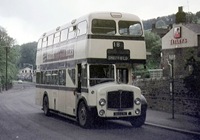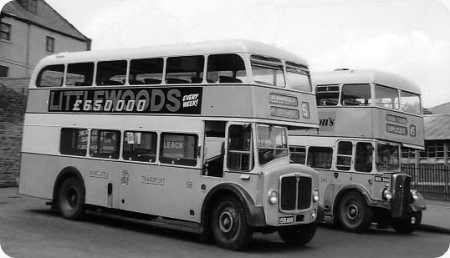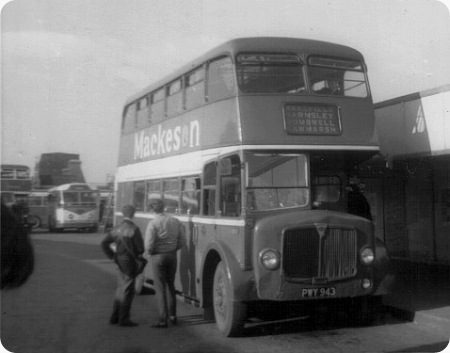Sheffield Corporation – AEC Regent V – 365 EWE – 1365
Sheffield Corporation
1963
AEC Regent V 2D2RA
Park Royal H38/32F
After several years of deliveries of rear engined double deckers, Sheffield bought batches of forward entrance for all three fleets in 1963 and 1964. This bus was from the first batch and is seen in May 1967 at the Oughtibridge terminus of service 18. Although four years old by this time, the bus appears to be in its original coat of paint with red lining below the lower blue band and the gold front fleet number.
Brian commented recently on Sheffield Bridgemaster 525 that it was used on the service 7 to Stannington, I think it more likely that the bus(es) he recalls was one of these not dissimilar looking vehicles which were regular performers on that service.
Photograph and Copy contributed by Ian Wild
A full list of Regent V codes can be seen here.
———
03/09/12 – 06:14
Strange how companies ‘borrow – steal?’ design ideas from each other, I would be hard pushed to spot the difference between some Alexander and MCW bodies, and to me the upper deck on this vehicle could have come straight out of the Orion stable rather than Park Royal
Ronnie Hoye
———
03/09/12 – 07:50
These were essentially Herries buses for the north of the city – including the bit of the West Riding which would become part of the city after the 1974 Local Government Act became law. The 18 was the Oughtibridge route (on the main Manchester via Flouch Inn corridor) but a favourite haunt for the park Royal regent Vs was the 91/98 Grenoside/Ecclesfield Circular. I thought that 64 – 73 with Weymann bodies were better looking but apparently they suffered from being amongst the last bodies completed at Addlestone and the quality of finish was not up to traditional Weymann standards. Pity, though. These were delivered to East Bank in August 1963 and spent their formative years on the 28/43 group of Herdings routes.
Ian, there is an extant picture of 525 (in Charles Halls’ book) on the 70 to Wombwell – so she did creep north of the city centre.
David Oldfield
———
04/09/12 – 06:44
Could it also be a BET Standard? BET "asked" PRV to change the original Bridgemaster from Classic PRV style and construction to steel framed "Box on Wheels" that it became. That is when PRV began to look more and more like the Orion.
David Oldfield
———
04/09/12 – 08:34
A pair of identical Regents ended up with Hebble when the Sheffield C fleet was disbanded in 1970. They always stood out by virtue of their Sheffield style indicators they were then passed to Yorkshire Woollen when Hebble disappeared a year later.
Chris Hough
———
05/09/12 – 06:50
That was 1150/1151 – and they were joined by some 1962 Atlanteans and the infamous ECW/PD2s.
David Oldfield
———
05/09/12 – 06:51
And after that, the two of them left Yorkshire for good, ending up with KMB in Hong Kong. They were rebodied with MetSec bodywork, and ended their days in a scrapyard, in the Chinese version of Barnsley!
Dave Careless
———
05/09/12 – 08:35
PRV and Roe both seemed to take a liking to those rather obvious ventilation extractors on the upper deck around this period – the fact that they weren’t more widely adopted might hint at their usefulness. To me, for some reason (familiarity perhaps?), two fog/spot lights have never looked right on a half-cab: I can only think of AEC fitting two fogs/spots, but did Leyland? – I’m sure I’ve never seen a Daimler or Guy with two. Whatever, to me this bus has a brutal purposefulness about it – a classic in terms of both design and livery.
Philip Rushworth
———
05/09/12 – 08:36
It’s only my opinion, but my vote for the best looking half cabs ever would go to the Park Royals of about the mid to late 50’s. Southdown had them, Newcastle had both high and low bridge versions on AEC Regent V chassis, Northern General Group had them on Guy Arab IV’s, and a later batch of PD2’s with rear doors. To be fair the Leeds Roe bodied Regent V’s were also a handsome beast, but I prefer the PR’s
Ronnie Hoye
———
05/09/12 – 08:37
Can you give us any details please, David, of how and when BET ‘asked’ PRV to alter their design and construction?
Roy Burke
———
06/09/12 – 06:48
Sorry, Ronnie, but my vote always goes to Roe. I will agree with you after that – and don’t forget the COMS Regents with similar PRV bodies.
Roy. Regret that I cannot give documentary details – I do not own the book that contained the information. (It was a paperback about significant prototypes vehicles.) Briefly: Crossley were allocated the task of developing the Bridgemaster and they were also producing a clone of Ronnie’s favourite PRV body at the time. Apart from being extremely attractive, it had, I believe aluminium construction – like the Routemaster. ACV were anxious to attract BET orders, but BET wanted a simple steel-framed construction with single skinned domes – in other words an Orion clone. This was around 1958, when Crossley finally closed down, and production moved to PRV in London. This resulted in the dreadful box-like front-end design of the Bridgemaster (even though initially the rear dome was the same as "standard") and the same single skinned interior panels (again like early lightweight Orions). I believe there is also passing reference in "The Blue Triangle" (Alan Townsin).
David Oldfield
———
06/09/12 – 07:19
With respect to the intake of the 1964/56 series of AEC Regent V/Park Royal vehicles I can add a little information on their purchase.
From the early sixties, Sheffield Transport Dept favoured the rear engined double decker, giving up to 78 seats. The general Manager C.T Humpidge, the successor to R.C.Moore from 1961, did favour the traditional front engine design. When the Sheffield Joint Omnibus Committee needed replacement vehicles, Mr Humpidge suggested that the AEC Regent/PRV version would be a cheaper option than the Atlantean or Fleetline.
Keith Beeden
———
07/09/12 – 07:33
Whilst I agree with David about the aesthetics and quality of traditional Roe body work, I do come down on the side of Ronnie in respect of the Park Royal double deck design of the mid 1950s. The PRV bodied Guy Arab IVs of Southdown – the body style with the deeper windows than the East Kent contemporaries – were, to my eye, the most handsome front engined ‘deckers of all time.
Roger Cox
———
07/09/12 – 07:34
Mention of C.T.Humpidge reminded me that after retiring from Sheffield Corporation he became The Reverend C.T.Humpidge. There cannot be many bus managers that have done that.
Philip Carlton
———
07/09/12 – 07:34
Philip’s "brutal purposefulness" description is very good because it really homes in on how Park Royal’s Orion clone differs from the Orion itself. Here’s an Orion for comparison www.old-bus-photos.co.uk/ The front tapers inwards in both an upward and forward direction (something that was taken to horrible extremes on tin-front Leylands), and in this case, though not always, is less perpendicular. Not nearly as brutal, is it?
Peter Williamson
———
08/09/12 – 07:11
Couldn’t agree more, Peter.
David Oldfield
———
08/09/12 – 07:12
Mr. J.P. Senior, former General Manager at Burnley, Colne and Nelson, then Assistant GM at Ribble became vicar of Heddon-on-the-Wall, Northumberland.
Eric Bawden
———
08/09/12 – 07:12
I’ve just discovered that the Park Royal site www.prv.org.uk/ has recently been updated with a large number of images, which are worth taking a look at. Many of them are rear-end views, which is very useful given the variety of rear domes that Park Royal used during this period, which tended to either accentuate or mitigate the box-on-wheels effect.
Peter Williamson
———
08/09/12 – 07:14
It is the front end perpendicularity (assuming there is such a word!) that I always found distasteful – whether on these, Bridgemasters or indeed front entrance Lodekkas (plus, of course, the original housebrick style Atlanteans). They all looked ungainly, as though they were about to trip over their front wheels and fall flat on their faces in the road! I’ll also earn some flak by saying that I liked the Orion, especially exposed radiator types. Well, having gone so far I may as well wreck what remaining credibility I have by saying I also liked the shape of the Leyland National – though I fully understand its innumerable mechanical shortcomings. Both it and the Orion dared to look like honest to goodness buses instead of space-age adaptations.
Stephen Ford
———
08/09/12 – 07:15
Philip, pictured elsewhere on this site is a 1959 Roe bodied PD3 Tin front, that also has two fog/spots. I certainly cant remember any other half cabs with more than one, even the twin headlight Green Line RMC’s only had one fog, so it may well be that the practice of fitting two was unique to Sheffield. However, since about 1982 I think, current legislation only allows front fog/spot lights to be fitted in pairs
Ronnie Hoye
———
09/09/12 – 07:32
The industrial smogs down the Sheffield river valleys could be pretty thick: to get people home in the evening perhaps you needed one for the kerb and one for the white line- or for the conductor walking down the middle of the road!
Joe
———
09/09/12 – 07:33
I’ve had a look round some of my photos to see whether two foglamps was unusual on half-cabs and I’ve noticed four trends:
No foglights – quite a lot of operators didn’t fit foglights at all. Most of the South Wales operators come into that category, but so do Manchester and Salford.
One foglight – some operators had a single foglight and didn’t modify the buses. Halifax is an example of this. Rhondda’s Regent Vs had a single one to the end although I did find one that had none.
Later fitment of second foglight – Oldham’s tin-front PD2s and exposed-radiator PD3s originally only had a single foglight but were later modified with a second one. The PD3s were so done at their 7-year CoF in 1971.
Always two – some operators always had two, or fitted the second at an early date. Southdown’s Queen Marys had two. Stockport’s fleet of PD2s and PD3s all had two, from the 1958 Crossley-bodied examples onwards. South Yorkshire is another surprising example – even their Bond-bodied PD2s had two. Rotherham’s 1965 Daimler CVG6s had two as well.
David Beilby
———
12/09/12 – 06:58
I recall these Regents at the small Bridge Street bus station, working services 91/98 to Grenoside as stated, also the 73 and 80 to High Green. They were the last front-engined buses in the Sheffield fleets.
The reference to smog reminds me that some operators had "fog on route" on their blinds. Oldham and Manchester were two, maybe others.
Geoff Kerr
———
23/11/12 – 16:04
The sound these wonderful buses made was my all-time favourite- with the possible exception of the Bristol RE.These were Sheffield’s only semi-automatic Regents and sounded very different to the other Regents in the fleet. 3150/1, as they were numbered after 1968, were the C fleet pair mentioned above. They were, I understand, bought for the 85 to Gainsborough, but by the time I reached Sheffield in 1969 they were used on city services such as the 150/151 to Shiregreen. This pair had overhead luggage racks downstairs! Hebble, who by January 1970 were in absolutely desperate straits vehicle-wise, grabbed them eagerly when the C fleet passed into NBC ownership on 1 Jan 1970.
Phil Drake
———
23/11/12 – 16:54
I seem to remember that the parcel racks in 1150/1 were of netting rather than having a solid base, quite unusual for a double decker.
Ian Wild
———
05/12/12 – 07:28
I always found the second B fleet batch slightly superior to the initial one at this time of year. Those 1368-1377 368-377HWE had fan heaters which didn’t stop when the bus did.
On the subject of Sheffields Half cab fog lights, I only ever remember the 31 forward entrance AEC half cabs having twin fog lamps in their service days, all other half cabs would have just a nearside one.
It was only when the PD3’s in particular were relegated to the ancillary fleet that the second offside ones appeared.
With the exception of the initial Alexander bodied Atlantean 369 all other Sheffield buses received after 1960 would all have twin fog lights
A shot of of ex-Sheffield PD3 909 on SCT61 when 23 with Stevensons fleet still only had the nearside one.
The pre-service shot of 461 at Crossgates only had the one.
Andrew
———
 Vehicle reminder shot for this posting
Vehicle reminder shot for this posting
———
23/12/12 – 17:05
To pick up on Phil’s contribution (23/XI/12) 1150-1/3150-1 were purchased for service 85 Sheffield-Retford-Gainsborough but, according to Alan Hinton’s Omnibus Society pamphlet about this route "neither racks nor vehicles were popular . . . and they rarely reached Retford [sic]". Partial double-decking of the route had started on 25/VIII/58, those through journeys which were double decked (the frequency was hourly between Sheffield-Retford, but only two-hourly between Retford Gainsborough) required a change to a single-decker at Retford. Initially PD2/Roe 1156-61 were allocated, being fitted with high-backed seats and platform doors. Then around 1960 it appears that "some Roe-bodied AEC Regent Vs from the B fleet were tried . . . but like most AECs they were not popular on this route" – why? In 1962 Leyland Atlantean/Weymann 1163-65 were purchased for the service, having high-backed seats and a "special upper-deck [sic] luggage compartment to accommodate . . . fishing baskets" (why on the upper deck? – to minimise smells??). In 1966 A-fleet Leyland Atlantean/Neepsend of the batch 348-60 took over double-deck operations – presumably C-fleet vehicles worked "A" services to balance the mileage. Until 17/III/68 the service was operated by Townhead Street garage and an outstation at the EMMS garage in Retford: on that date Townhead Street garage closed and Greenland Road garage assumed responsibility for workings using the 1962 C-fleet Atlanteans, now renumbered 3163-5. Single-deck operations were, from 1960, entrusted to the Burlingham and Weymann Fanfare bodied Leyland Leopards, but latterly became the preserve of A-fleet AEC/PRV Swifts – some of which had their seating capacity reduced to provide extra luggage accommodation for the role. Alan Hilton’s pamphlet really is a most fascinating history of this route.
Philip Rushworth
Quick links to the - Comments Page - Contact Page - Home Page




